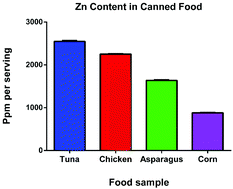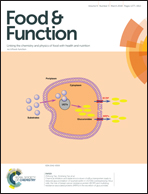Retracted Article: ZnO nanoparticles affect intestinal function in an in vitro model†
Abstract
Zinc oxide nanoparticles (ZnO NP) may be present in food packaging, which would put consumers at risk of NP ingestion. There is little information on the amount of ZnO NP that are present in food packaging and the effects of ZnO exposure on intestinal function. To estimate physiologically relevant ZnO exposures, foods that are naturally low in zinc (Zn), but are commonly packaged with ZnO NP, such as tuna, corn, and asparagus, were analyzed with inductively coupled plasma mass spectrometry (ICP-MS). It was found that the Zn present in a serving of these foods is approximately one hundred times higher than the recommended dietary allowance. An in vitro model of the small intestine composed of Caco-2 and HT29-MTX cells was used to investigate the effects of ZnO NP exposure. Cells were exposed to physiologically realistic doses of pristine NP in culture medium and to NP subjected to an in vitro digestion to better reflect the transformation that the NP may undergo once they enter the human GI tract. Uptake and/or transport of iron (Fe), Zn, glucose, and fatty acids were assessed and intestinal alkaline phosphatase (IAP) levels were measured before and after NP exposure. The findings show that there is a 75% decrease in Fe transport and a 30% decrease in glucose transport following ZnO NP exposure. These decreases were consistent with gene expression changes for their transporters. There is also evidence that the ZnO NP affect the microvilli of the intestinal cells, therefore reducing the amount of surface area available to absorb nutrients. These results suggest that the ingestion of physiologically relevant doses of ZnO NP can alter intestinal function in an in vitro model of the human small intestine.



 Please wait while we load your content...
Please wait while we load your content...